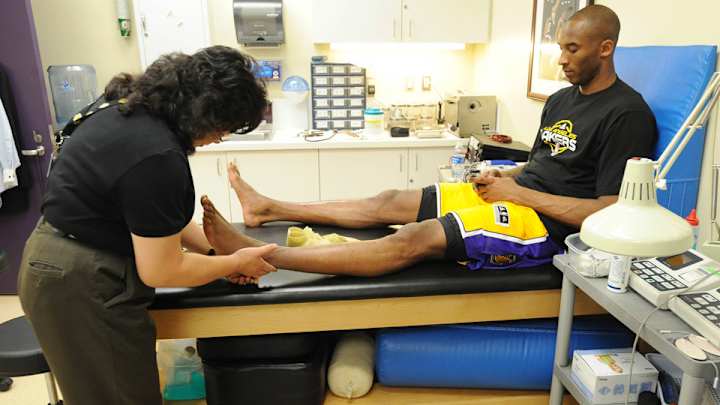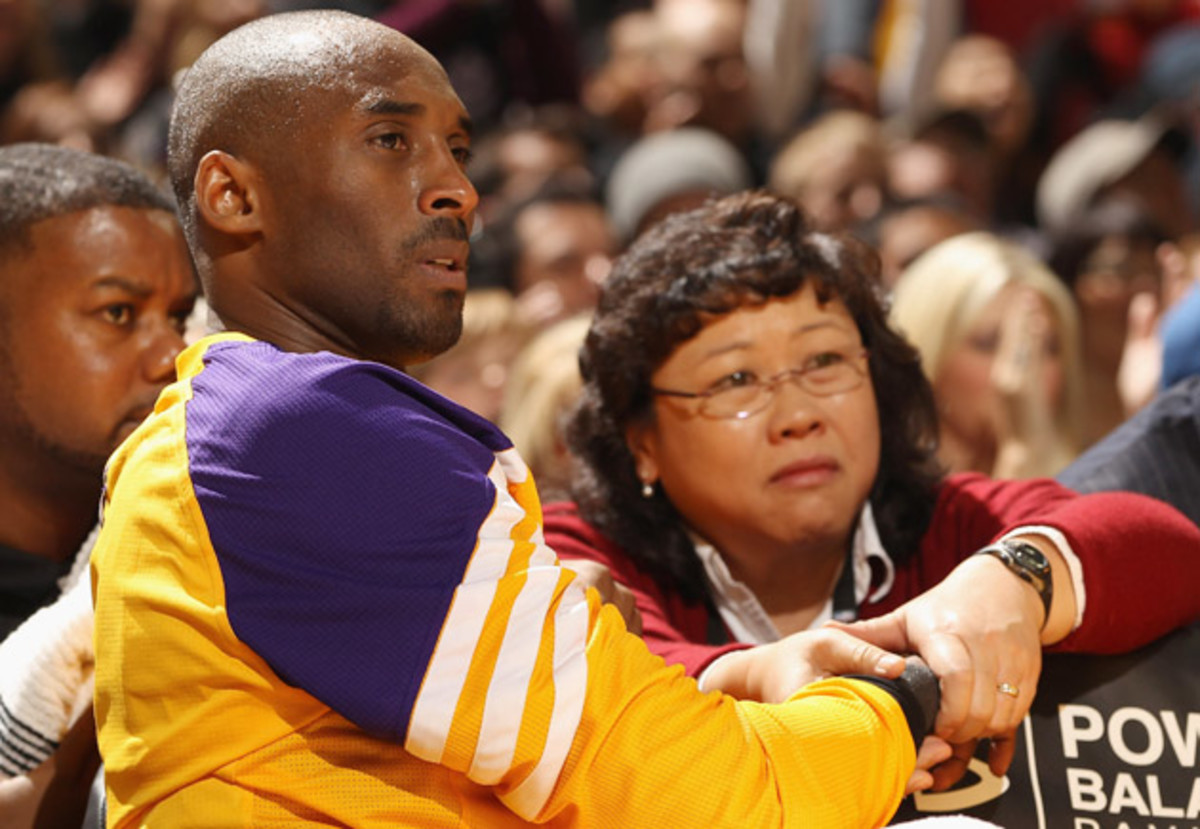Examining Kobe Bryant's legendary pain tolerance and road to recovery

For a recent SI Longform story, I spoke with Judy Seto, the longtime physical therapist for Kobe Bryant and the Lakers. The excerpts from our conversation focus on Bryant, his recovery and his singular pain tolerance. Quotes edited for clarity.
Kobe's medical expertise
"He's the kind of guy that he knows his body. He's been through so many injuries. He knows…how things connect and work. He's been doing that his whole life. He's been building on that from year one. So he's much further along than most people. He's much further along than most people," says Seto. "Even for a lot of athletes, they don't take the time and interest to understand the nuances. Everybody is a little bit different. Some people it's like, 'You just tell me what to do, I'll do it, I don't really need to understand.'
He's on the other end of the spectrum. 'Tell me what's going on, what are you doing, why this, why that, how is it going to help me, why not that?'….He could speak to another medical professional and keep up with the conversation no problem. "
MORE NBA: Western Conference power rankings | Eastern Conference
Gaining Kobe's trust
"You have to earn his trust. I mean, he doesn't give it just to anyone. I think he's met so many people along the way that come to him and say, 'I have the magic pill, I have the magic bullet.' It's hard to weed them out.
Even if you might come highly recommended, he's still going to make sure that you pass his level of trust. It's not like, 'Oh, just because you recommend a person, I'm going to automatically...' [Instead] 'I'm going to have some questions, test them out, give them a try. If they don't match up to what I need, it's not going to happen.'"
Kobe's remarkable pain threshold
Kobe Bryant on growing old, players he respects and finding his inner Zen
"It's the highest that I've ever seen. He channels his focus so well in terms of just the task at hand. But also when he's had pain, he can block that out. I mean, I think a good example is when he tore his Achilles, he made those free throws. He blocked it out and focused. He didn't let his mind go to the place of, 'Oh, my gosh.' At one time it was a career-ending injury. Your mind starts to wander and go down that road. Everyone around you, the distraction, not only your team is wondering how you're doing, the other team, the game, the fans in the stands, everything.
"But he just focused on this. I think that's what makes him who he is. I mean, he can take that and just block everything else out, including pain. Like I said, he's not a reckless person. He wasn't going to cause more damage by going out there and shooting his free throws. It was fine for him to do that. It's just amazing.
"One of the things I saw that cemented for me his pain level, besides that episode, was he dislocated his finger. I think he was playing I want to say Cleveland, maybe Miami. But it was during the first quarter. He dislocated his finger. It's basically like, this bone was over here. The head trainer, during a timeout, he relocated it, had him go back in.
"I think that trait makes him who he is, and his ability to focus also allows him to channel his energies. It's not that he doesn't feel pain; it's how he responds. Everybody responds to pain a little differently. There's some people that if you have an injury, you perseverate on it, an injury here can manifest to an injury over here or somewhere else in your body. It can be extremely debilitating. That's the other stream.
"…But he's at a level where he does not allow it to control him. But that's how he is with so many aspects of his life, so... I think that's why he is who he is. "

Measuring Kobe's pain
Usually Seto measures a patient's pain on a scale of 1-10. But with Bryant, "I don't even ask him. He just looks at me. 'Why are you even asking me this? What's the point?'
"So there's no point in asking him, 'How bad is your pain?' He would just go, 'Why are you asking me about my pain? Just take care of whatever the problem is and let me get back to what I need to do, or I can't do it, so tell me I can't, then we'll deal with it.'
"It's kind of like useless. I mean, I'll have to ask him, 'Does it hurt?' I have an obligation to ask. But I don't think I've asked on a scale of zero to ten how much it hurts because it doesn't matter for him."
Kobe on the road
The NBA's rigorous schedule plus a busy offseason leads Bryant to be on the road a good portion of the year, but the training doesn't stop.
"Being on the road a lot, traveling, you have to learn to adapt," Seto said. "If the hotel gym doesn't have it, there's going to be a local gym that probably has a little bit more. When I've traveled with him, I've scouted out. We know ahead of time what we've got. If there's a better option, we're going to find it.
"I remember last summer when we were traveling in Europe, we were in Milan. He had already contacted AC Milan to use their AlterG-Treadmill which is one where you can take off some body weight. I think that might have been one of the few in Milan, or there aren't that many in Italy.
"It doesn't have to be elaborate. We don't have to have a whole entire Equinox, Spectrum Club, whatever where we travel. You get a lot done with certain equipment. You can adapt."
Asked if there was one exercise machine she could have on the road for Kobe, Seto chose a versatile lower-body option.
"There's a machine called a Shuttle. It's a leg press. It's multifaceted because you can change the resistance. But you can do leg press exercise, you can do explosive jumping off of it, you can do calf work, you can do core work, you can do glute work, hip work, hamstring work. There's all these different things that this piece of equipment can assist you with.
"A lot of times it's maybe a piece of equipment that maybe wasn't designed to do that, but you can adapt it, tweak it a little bit, have it be what you want it to be.
You can give me a piece of rubber tubing and we can probably do 500 exercises with it. It's just a piece of rubber tubing."
Kobe's knee injury last season
At first, Seto wasn't sure how severe Bryant's knee injury was when he went down last December.
"From the tape, it happened so quickly. It's not the first time he's ever hyperextended his knee, which is how it happened," Seto said. "I mean, it's not an uncommon thing. Guys hyperextend all the time. This one, for whatever reason, it bothered him.
"It's kind of like (Steve) Nash. He's been hit a million times playing basketball or any sport, soccer. Why that time did it break? It's the same thing, 'Why this time?' It was almost like a nothing play. He didn't get bad contact, he didn't fall, none of that. So it didn't seem that serious at the time.
"I mean, with the Achilles, that's a little bit more obvious. He knew something was wrong right away. So it wasn't that like red flag."
Adding to Seto's uncertainty was the fact that Kobe was able to get up and walk after suffering the injury.
"With that type of injury, it's not until you get to a certain position or an angle that you're going to contact that part of your knee where he had that fracture," she said. "So until you actually jam it again, you're not going to feel it. It's not like, Oh, my gosh, I broke my entire tibia and now it's unstable, or I broke my femur, the whole thing is unstable and I cannot go."
Kobe had suffered a lateral tibial plateau fracture in his left knee, an injury that even the Lakers star couldn't fight through.
"With a fracture, it takes time. It has a mind of its own," Seto said. "It’s not like it's an ankle sprain and you can work through it, tape it up. A fracture, if you don't take care of it, it could potentially get worse. So we're not going to take that chance with anyone, especially someone like him. It was definitely disappointing."
Road to recovery
Kobe didn't have much swelling or pain after suffering last year's knee injury, making his immediate recovery fairly simple. No complications, just keep the area stable. Bryant didn't even need to wear a brace, although Seto stressed the importance of rest and rehabilitation.
"He didn't really have pain unless you contact it," Seto said. "It's kind of like if you have a cut, if you don't touch it and rub it and everything, you know, you're not going to feel it unless you do, irritate it somehow. But you've got to let it heal. If you keep on picking at a scab, it won't heal.
"If he were to continually test it and push it, it was just going to take a lot longer. That's the hardest thing for him, letting it sit and heal. He already had to go through that with the Achilles. He had to wait and allow the natural, physiological process and the healing time we know. Soft tissue, it needs to go through the same thing for bony healing. You cannot speed it up. People say we have a magic pill, it's going to heal up. The body still has to go through a certain process."
Seto said if you rush back too early from an injury this severe it can lead to a bigger break or ligament damage due to overcompensation.
"If you get a sports injury to your hip or whatever, you're going to put stresses on other parts of or body and use your body a little bit differently because maybe you don't have the range of motion, so you end up compensating in other parts of or body to allow you to get from Point A to Point B.
"All you know is you want to accomplish whatever your goal is, to get from Point A to Point A, whether it's right or wrong. Your body is going to have to take up the slack somehow. Sometimes the body is fine, it can handle it. There's no telling how your body is going to respond that day.
"Some people respond and compensate the same way every time. So there's a pattern. Some people respond differently almost every day. It's almost like I call it a smart chip. So your body maybe this day it's going to compensate by putting more pressure in one part of your body, maybe your hip. Another day it might be your knee, it might be your ankle. Wherever it can go. It's a path of least resistance."
To read the full SI Longform on Bryant, click here.
[onetwenty=91105808]
